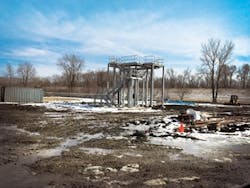About the author: Amy McIntosh is associate editor for W&WD. McIntosh can be reached at [email protected] or 847.954.7966.
The village of Roxana, located in southeastern Illinois just east of downtown St. Louis, is home to the 350,000-barrel-per-day ConocoPhilips oil refinery. The Roxana Water Treatment Plant provides potable water to the 3,600 residents of Roxana and South Roxana, industrial customers and the refinery—the plant’s largest water user.
“When I started with the village, an average day of production was 0.5 million gal per day (mgd),” said Marty Reynolds, retired public works director for the village. “Because of the growth and development in the area, annexation and expansions, and selling water to another community for industrial use, our average day is around 1.1 mgd now. The plant effluent has basically increased 100% in the last 20 years.“ The plant is rated to produce 2 mgd.
A Rocky Road
The original plant was built in 1977 and experienced its share of treatment challenges from the start. The initial plant design was for a lime- softening process, but the village was unable to find land suitable for process waste lagoons to dispose of the precipitated solids. As a result, the plant became a groundwater oxidation/filtration ion exchange softening facility.
Approximately four months after the plant went online, iron and manganese levels in the raw water tripled, exceeding U.S. Environmental Protection Agency (EPA) standards.
“We could meet primary standards—just barely—and stay under the maximum contaminant level, but we were running about 100 to 110 µg/L of soluble manganese in the plant effluent and the EPA secondary standard is 50 µg/L,” Reynolds said. “We had customer complaints weekly, if not daily. We would flush water mains monthly, trying to keep the manganese dioxide from building up inside the water mains. We fought that process really hard for two years.”
By increasing the ion exchange softening rate, the plant was able to remove some of the manganese at the expense of the ion exchange resin. Sodium bisulfite, an ion exchange cleaning compound, introduced into the brine water regenerated the ion exchange softeners to preserve the media.
In the early 1980s, the village constructed an additional building at the plant, which included an upflow clarifier. A potassium permanganate feed and a polymer were added between the old reaction basin and the new upflow clarifier, which solved the problems associated with the elevated iron and manganese levels.
Simplifying the Process
In 2008, after several attempts to rehabilitate aging equipment, plant operators began researching a more efficient treatment process. At the same time, the village was planning to construct a wastewater treatment plant less than a mile from the water plant. This property had enough space for the water plant to construct the process residue basins necessary to accommodate the lime-softening process that was originally planned 30 years earlier.
“That’s when we thought, we’ve got to rebuild this plant anyway, so let’s switch from ion exchange softening to lime softening, which will minimize three of the treatment chemicals that we currently use to meet finished water standards,” Reynolds said. “With the wastewater plant allowing us to process additional solids loading from the water plant, it made sense to switch the entire treatment scheme when this plant was being modified.”
The village embarked on an $8 million expansion and renovation of the existing water treatment plant, which currently is underway. The plant will employ a liquid hydrate batching system that produces a hydrated lime mixture, known as “liquid lime,” that contains approximately 35% lime.
Curry and Associates Eng. is the project’s designer. Contegra Construction Co. is installing a forced draft aerator, lime and polymer feed systems, a carbonic acid feed system, chlorine and fluoride chemical feed building and feed systems, four new concrete gravity filters with a filter effluent head tank and two transfer pumps. An additional 500,000-gal bolted stainless steel ground storage tank will increase the plant’s storage capacity from 1.15 million gal to 1.65 million gal. The team is targeting completion in the early fall of 2015.
“It’s been an interesting process and the village has been fortunate through the years to be able to acquire the funding to keep expanding and improving our processes,” Reynolds said. “I think this process will be the best one yet in terms of providing potable water that’s a lot easier to treat.”
Download: Here
